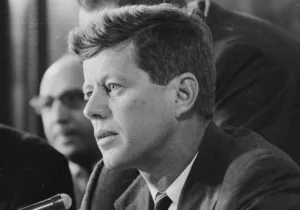“A Problem of Evangelical Christianity,” by Reinhold Niebuhr
May 13, 1946
The occasion which prompted these reflections on the state of Evangelical Christianity was an early morning Easter service in a large movie auditorium. Easter is supremely the climax of the Christian church year. The incredible Easter story of the empty tomb gains credibility only as a part of, and against the background, of the whole Christian story. The Christian faith is, that if we die with Christ we will also be raised with Him. The idea has a double significance. St. Paul seems sometimes to be thinking primarily of the dying to sin and the rising to righteousness, and at other times primarily of the guarantee in Christ of the victory over death.
In any event Easter is a day in which men ought humbly to consider all the false and pretentious ways by which they have sought to live and to cover up the insecurity, frailty and sinfulness of life; and joyfully to realize that there is forgiveness and resurrection for those who are of penitent heart. It is a question whether any sermon, even the best, can convey the Easter message and hope, if the whole atmosphere of the Gospel is not created and recreated in prayer and song.
Evangelical Christianity in all of its various varieties began as a protest against formal religion. It believed that the formal prayer and the theological subtleties of the traditional church did not sufficiently emphasize that we cannot live with Christ if we will not die with Him. It desires, so to confront the soul with Christ, that as Judge he would drive the old self to despair and that as Redeemer he would transmute despair into repentance; and repentance into a new life. Evangelical Christianity desired, in other words, a more powerful impact upon the souls of men than the traditional offices and services of the church afforded.
One could not help but be struck by the sorrowful contrast between the desire and the reality as one worshipped on Easter morning in the movie palace. Nothing symbolizes the tawdriness of our modern culture more obviously than the moving picture palace. Not that any of the nice combinations of sentimentality and eroticism which is the daily fare of the movie audience obtruded this Sunday morning. The palace itself was chaste and free of the usual gimcracks which usually disfigure these places. One had the feeling that the directors of the palace were doing their level best to make the place fit for a Christian service. But such things cannot be done overnight. What was painfully evident was that the most non-Christian form of modern culture cannot provide the forms for a genuine Christian service of worship. The arrangements for the service were obviously left in the hands of the movie people. They did the best they could to transform a movie palace into the semblance of a church. There was a backdrop of a cathedral window. Between the choir and the window was a curious arrangement which might have been intended for an altar laden with Easter lilies. Yet it looked more like a huge coffin, smothered in flowers. Perhaps a cemetery scene was really intended; for before the altar-catafalque was a gilded fence with large gates. On each side stood figures which might have been angels or again they might have been props left over from some medieval decor.
The service began with the house in darkness and the gradual lighting of the stage, symbolizing the Easter dawn. The organist appeared with the spotlight upon him as his console emerged, trickily and automatically from its cubicle to full view. The choir was for some obscure reason gowned in a symphony of colors from deep blue on the outside to bright red at the center. I do not know what this symbolized and could not make up my mind whether it represented something left over from some spectacle or whether the red at the center was meant to be the rising sun. There was the usual rather exhibitionist choir director who spoiled by his antics what would otherwise been quite acceptable Easter music. This exhibitionist director is one of the symbols of what the evangelical church has in common with the theatre.
The whole trouble was that the movie people were quite obviously intent upon producing a “spectacle.” That is what they are adept in. They wanted it to be subdued and solemn, but nevertheless a spectacle. They quite obviously wanted to make a real contribution to “religion.” Here was a church service with so little of its own to go on that movie technic could dominate the spirit of it completely. The one adequate note of Christian faith and hope was expressed in a brief and simple but adequate and helpful sermon on the text “Thanks be to God who giveth us the victory through our Lord Jesus Christ.”
Perhaps one ought not to be too critical. I am sure that the leaders of united Protestantism in our city were grateful that this great movie palace was filled with seven thousand worshippers at 7 A.M. on Easter morning. But the real trouble lies with the fact that we were not worshippers and could not be. There was nothing in the symbolism or in the service which might prompt us to behold the “beauty of the Lord” or His Majesty or the mystery of His Mercy. There was of course a “general” prayer which touched upon the themes of the Christian faith but no great act of adoration and praise, of penitence and contrition. Here there was no chance to confess that our life, as “carnally minded” leads to death, and to praise God for the grace by which death can be transformed into life, love, joy and peace.
One must not put too much emphasis upon a single service or upon a single symbol of the religious inadequacy of modern Evangelical Protestantism. The service had significance chiefly because it revealed the tragic problem of modem Protestantism. The formlessness of its worship sometimes achieves its own form in the simplicity of a village meeting house. But this formlessness is inadequate when confronted with the potent forms created by a modern secular culture. The forms of that culture suggest a content; and it is not the Christian content. The Evangelical Christianity of the frontier of yesterday cannot be transported into the highly competitive cultural currents of a modern metropolis and maintain itself without more adequate instruments. The old Evangelical spontaneity is lost in any event even in the village chapel. The Christian faith requires conduits of an adequate theology, an adequate liturgy and an adequate symbolism of worship. These forms are always in danger of becoming empty and require periodic protests against “devotion’s every grace except the heart.” But religious spontaneity without adequate forms degenerates into something even more graceless than a graceless formalism. It degenerates into a void which is filled by the potent symbols of a cinema secularism.
I left the “dawn” service and betook myself to a liturgical church and participated in Holy Communion with my family. The simple communion service offered the possibility for the expression of every genuine Christian impulse of worship, and contained all the sublime affirmations of the Christian faith and hope.
The service held me completely enough so that it was only after it was over that I speculated ruefully upon the fact that I could not have received communion in this church except for the fact that the church was touched by the slightly heretical broad-mindness which the academic community had imparted to it. The liturgical churches, whether Lutheran or Episcopalian, fail to help the main body of Christianity in America because they set up barriers to fellowship, more formidable than is necessary to guard their peculiar treasures of faith and tradition. Thus they retain as a peculiar possession what should be flowing into the whole body of the church.
Our problem would not of course be solved by merely imitating their forms. Already that is producing in some non-liturgical churches theatrical versions of a liturgy and forms in which a sentimental aestheticism is more obvious than a Biblically inspired common worship.
The Christian faith in America faces many perplexing problems in expressing itself adequately amidst the confusions of modern culture and civilization. The problem which was illumined by this Easter service may not be the most primary. But it is certainly important. Ought there not be in America some real movement for the reconsideration of the relation of faith to worship and of worship to forms? Are not the experiences of our chaplains in the army, proof of the same void which this Easter service revealed?






 Live in the DC area? Sign-up for Providence's in-person events list!
Live in the DC area? Sign-up for Providence's in-person events list!